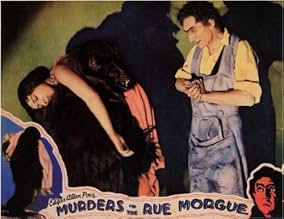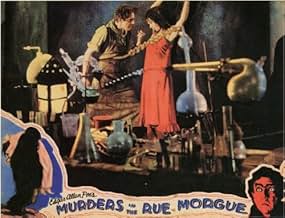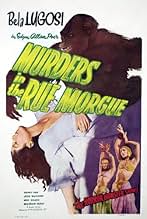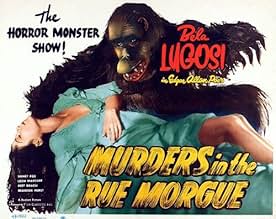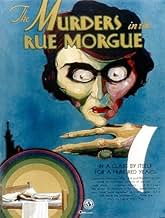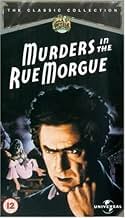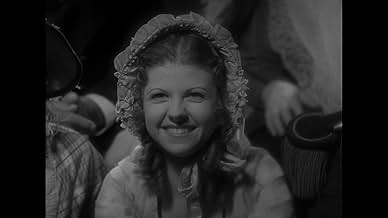IMDb RATING
6.3/10
5.8K
YOUR RATING
A mad scientist seeks to mingle human blood with that of an ape, and resorts to kidnapping women for his experiments.A mad scientist seeks to mingle human blood with that of an ape, and resorts to kidnapping women for his experiments.A mad scientist seeks to mingle human blood with that of an ape, and resorts to kidnapping women for his experiments.
- Awards
- 2 wins total
Leon Ames
- Pierre Dupin
- (as Leon Waycoff)
Ted Billings
- Sideshow Spectator
- (uncredited)
Herman Bing
- Franz Odenheimer
- (uncredited)
Joe Bonomo
- Gorilla
- (uncredited)
Agostino Borgato
- Alberto Montani
- (uncredited)
Iron Eyes Cody
- Indian at Sideshow
- (uncredited)
Christian J. Frank
- Gendarme Using Snuff
- (uncredited)
Charles Gemora
- Erik, the Gorilla
- (uncredited)
Harrison Greene
- Sideshow Barker
- (uncredited)
Charlotte Henry
- Blonde Girl in Sideshow Audience
- (uncredited)
Featured reviews
I won't go into the plot details as many have done that before me, but "Murders in the Rue Morgue" is worth a look for several reasons.
The first is the overall look of the film from legendary DP Karl Freund (Dracula, Metropolis, and many others). The sets are outstanding, the lighting is great, and the overall atmosphere is perfect. Everything comes off as some creepy nightmare.
The second reason to see "Murders" is Bela Lugosi, who owns every scene he is in. He is sufficiently strange and intimidating as the mad doctor.
The third reason is the overall story line. OK, forget the whole mixing of the ape and human blood thing and this movie is very similar in plot line to "The Cabinet of Dr. Caligari", just substitute the ape for Cesare the Somnambulist. It also contains some very strong (for its time) scenes involving the doctor "administering" to his patients.
OK, now some things that aren't so hot.
First, the cutting between the man in the ape suit and the real ape's face is distracting. The shots don't match and some serious suspension of disbelief is required for this not to be a deal breaker. I've heard that Florey's film was cut against his wishes to add these scenes and remove others. That would explain why these scenes seem out of place.
Also, as others have referred to, the comic relief is really not very good. At the time, however, this type of thing was common in films that were thought to be very intense. The comedy was used to relieve the tension so the audience could be set up for the next batch of horrors. Most of it doesn't work in this film.
Overall, I felt this film was well worth a look, and I've watched it several times just to admire the outstanding work of Karl Freund.
The first is the overall look of the film from legendary DP Karl Freund (Dracula, Metropolis, and many others). The sets are outstanding, the lighting is great, and the overall atmosphere is perfect. Everything comes off as some creepy nightmare.
The second reason to see "Murders" is Bela Lugosi, who owns every scene he is in. He is sufficiently strange and intimidating as the mad doctor.
The third reason is the overall story line. OK, forget the whole mixing of the ape and human blood thing and this movie is very similar in plot line to "The Cabinet of Dr. Caligari", just substitute the ape for Cesare the Somnambulist. It also contains some very strong (for its time) scenes involving the doctor "administering" to his patients.
OK, now some things that aren't so hot.
First, the cutting between the man in the ape suit and the real ape's face is distracting. The shots don't match and some serious suspension of disbelief is required for this not to be a deal breaker. I've heard that Florey's film was cut against his wishes to add these scenes and remove others. That would explain why these scenes seem out of place.
Also, as others have referred to, the comic relief is really not very good. At the time, however, this type of thing was common in films that were thought to be very intense. The comedy was used to relieve the tension so the audience could be set up for the next batch of horrors. Most of it doesn't work in this film.
Overall, I felt this film was well worth a look, and I've watched it several times just to admire the outstanding work of Karl Freund.
"Murders In the Rue Morgue" was Universal's follow up for star Bela Lugosi after the huge success of "Dracula" (1931). He did appear in other films during this period but mostly in minor roles. In fact, in one of the worst career moves of his career, Bela had turned down the role of the monster in "Frankenstein" (1931).
This film made in 1932, two years before the introduction of the infamous Production Code, contains many situations that would have not been allowed under the Production Code. For example, even the suggestion of a liaison between an ape and a woman would have never been allowed and the clear identification of a prostitute likewise. It's probably why this film was not seen for many years.
Lugosi, donning his mad scientist hat, plays the mysterious Dr. Mirakle who works in a carnival sideshow in 1845 Paris. He displays his man-like ape (actually it looks like a full grown chimpanzee) Erik while searching for a human female to presumably mate with the monster. One night pretty Camille L'Espanaye (Sidney Fox) and her beau, medical student Pierre Dupin (Leon Waycoff) visit the carnival and take in Dr. Mirakle's show. During the show, the ape is give the girl's bonnet and becomes obsessed with her.
Meanwhile we learn that Mirakle has been searching for the right blood match for his pet. We discover that two women have been murdered (offscreen) already. One dark night, Mirakle comes upon a "woman of the streets" (Arlene Francis) who has just witnessed the deaths of two "suitors" in a knife fight. The good doctor lures the poor wench to his laboratory where we witness his torture of her and her rather cold disposition of her corpse when she dies after she is injected with the ape's blood.
All the while Mirakle has kept his eye on the comely Camille. Then one night he sends the ape to Camille's room and..............
The film is well directed by Robert Florey who utilizes Universal's dark fog filled sets to great effect. Lugosi is quite terrifying in this role. Although he did get teamed with Boris Karloff in the mid thirties, he never achieved the heights he should have at Universal. With his personal off screen problems well documented, he made a number of poor choices in his movie roles. During the period when his star should have been rising he kept appearing in cheap poverty row features and serials which did little to advance his career.
Others in the cast include Bert Roach as Paul, Pierre's friend, Brandon Hurst as the Prefect of Police and D'Arcy Corrigan as the Morgue Keeper.
A very young John Huston contributes some additional dialog for the story. Leon Waycoff became Leon Ames and enjoyed a lengthy career as a character actor.
One of Lugosi's best.
This film made in 1932, two years before the introduction of the infamous Production Code, contains many situations that would have not been allowed under the Production Code. For example, even the suggestion of a liaison between an ape and a woman would have never been allowed and the clear identification of a prostitute likewise. It's probably why this film was not seen for many years.
Lugosi, donning his mad scientist hat, plays the mysterious Dr. Mirakle who works in a carnival sideshow in 1845 Paris. He displays his man-like ape (actually it looks like a full grown chimpanzee) Erik while searching for a human female to presumably mate with the monster. One night pretty Camille L'Espanaye (Sidney Fox) and her beau, medical student Pierre Dupin (Leon Waycoff) visit the carnival and take in Dr. Mirakle's show. During the show, the ape is give the girl's bonnet and becomes obsessed with her.
Meanwhile we learn that Mirakle has been searching for the right blood match for his pet. We discover that two women have been murdered (offscreen) already. One dark night, Mirakle comes upon a "woman of the streets" (Arlene Francis) who has just witnessed the deaths of two "suitors" in a knife fight. The good doctor lures the poor wench to his laboratory where we witness his torture of her and her rather cold disposition of her corpse when she dies after she is injected with the ape's blood.
All the while Mirakle has kept his eye on the comely Camille. Then one night he sends the ape to Camille's room and..............
The film is well directed by Robert Florey who utilizes Universal's dark fog filled sets to great effect. Lugosi is quite terrifying in this role. Although he did get teamed with Boris Karloff in the mid thirties, he never achieved the heights he should have at Universal. With his personal off screen problems well documented, he made a number of poor choices in his movie roles. During the period when his star should have been rising he kept appearing in cheap poverty row features and serials which did little to advance his career.
Others in the cast include Bert Roach as Paul, Pierre's friend, Brandon Hurst as the Prefect of Police and D'Arcy Corrigan as the Morgue Keeper.
A very young John Huston contributes some additional dialog for the story. Leon Waycoff became Leon Ames and enjoyed a lengthy career as a character actor.
One of Lugosi's best.
After the enormous success of Tod Browning's "Dracula" in 1931, producer Carl Laemmle Jr. finally proved that his vision had been correct and that the horror genre was an excellent source of stories to film. With that in mind, he began to work immediately in a follow up for that success with an adaptation of Mary Shelley's immortal novel, "Frankenstein", in the expressionist Gothic style of Browning's film. The film was set to be written and directed by French director Robert Florey and starred by the recently discovered Hungarian star of "Dracula": Bela Lugosi. However, people at Universal changed the plans and assigned the film to British director James Whale, who had a different idea for the movie and replaced Lugosi with Boris Karloff. Owing a film to both Florey and Lugosi, Universal gave them a project based on a tale by Edgar Allan Poe: "Murders in the Rue Morgue".
Set in Paris during the late 19th Century, "Murders in the Rue Morgue" is the tale of a series of unsolved crimes where women are abducted and murdered by an unknown method. Since the murders began to take place after a carnival arrived to the city, young medicine student Pierre Dupin (Leon Ames) suspects that Dr. Mirakle (Bela Lugosi), a scientist who owns one of the sideshow attractions, is behind the crimes, but so far he finds himself unable to prove it. His suspicion has its source in the fact that Mirakle has claimed to be looking for a way to finally prove that man and ape are related, and apparently has been experimenting on his sideshow attraction: an intelligent ape named Erik, which Mirakle claims is the missing link. Dupin fears that Mirakle's experiments are related to the murders, but the truth is far more horrible than what he thinks.
"Murders in the Rue Morgue" is not exactly a faithful adaptation of Poe's short story, as the script (written by Tom Reed, Dale Van Every and Robert Florey himself) focuses more on the reasons behind the murders than on the investigation done to solve the case. It is because of this reason that it is Dr. Mirakle who is in the spotlight while Poe's famous character, Dupin, has been transformed from cunning detective to a young student of medicine. With this change, the writers allow themselves to completely focus on horror, and deliver one of the darkest and most violent stories among Universal's classic horrors. However, as many have already pointed out, the story is not only an exploration of Poe's tale, but also a charming tribute to German expressionism's most celebrated triumph, "Das Cabinet Des Dr. Caligari", as the plot mirrors the classic silent film in more than one way.
The tribute to "Caligari" is not only a part of the script, as director Florey, aided by the legendary cinematographer Karl Freund and the wonderful art direction by Charles D. Hall, extended the tribute to the overall visual look of the film, following the expressionist style to the letter with an amazing use of light and shadows to create a powerful and haunting atmosphere. However, not everything is lifted from German expressionism, as Florey adds his own realist style to the mix resulting in a powerful combination that enhances the violence of the script. As the film was done before the Production Code was introduced, Florey manages to bring to life a lot of the vicious images of the script with an amount of detail that would be impossible a few years later. Sadly, Florey's skills at directing actors aren't as good as his skills with the camera, and some bad performances end up damaging the movie a lot.
While Florey doesn't seem to direct his actors as good as he does with the visuals, Bela Lugosi shows off his talent in a tremendous performance that's probably among the best of his career. As Mirakle, Lugosi is incredibly believable as a demented scientist, and despite being one of his most menacing roles he even manages to be sympathetic at times. The sadly ill-fated Sidney Fox is also good as Camille, the damsel in distress of this eerie horror, but sadly her counterpart, Leon Ames, isn't up to the challenge. While he later proved to be a talented actor, in this movie Ames delivers an awful performance that looks stagy and simply out of place in the movie. Bert Roach, who plays his sidekick, is not much better, as his delivery of comic relief is mediocre at best and ludicrous at worst.
This varying quality of the performances and the sharp contrast between them and the superb visual look of the movie may had played a part in the relatively disappointing reception the film had at box office, but the main reasons the movie failed was probably the fact that the audience wasn't ready for the dark nature of the plot and the violence displayed on screen. In fact, there are rumors stating that Universal removed almost 20 minutes of the original cut, taking away scenes supposedly too violent for being released. Anyways, whether this rumor is true or not is ultimately irrelevant, as the film's main problem is still in the actors' performances and that's something that missing footage hardly could improve. It is a shame that one of Lugosi's best performances ends up in the same film as one of Ames' worst.
Despite its many troubles, Robert Florey's "Murders in the Rue Morgue" is still an effective tale of horror and mystery that keeps the classic Universal feeling to the max. Dark and atmospheric, it is also an unusual movie due to its raw portrayal of violence on film. While not exactly a classic of the level of Universal films like "Frankenstein" or "The Black Cat", this movie is definitely a must see if only for Karl Freund's masterful cinematography and Bela Lugosi's amazing performance. 7/10
Set in Paris during the late 19th Century, "Murders in the Rue Morgue" is the tale of a series of unsolved crimes where women are abducted and murdered by an unknown method. Since the murders began to take place after a carnival arrived to the city, young medicine student Pierre Dupin (Leon Ames) suspects that Dr. Mirakle (Bela Lugosi), a scientist who owns one of the sideshow attractions, is behind the crimes, but so far he finds himself unable to prove it. His suspicion has its source in the fact that Mirakle has claimed to be looking for a way to finally prove that man and ape are related, and apparently has been experimenting on his sideshow attraction: an intelligent ape named Erik, which Mirakle claims is the missing link. Dupin fears that Mirakle's experiments are related to the murders, but the truth is far more horrible than what he thinks.
"Murders in the Rue Morgue" is not exactly a faithful adaptation of Poe's short story, as the script (written by Tom Reed, Dale Van Every and Robert Florey himself) focuses more on the reasons behind the murders than on the investigation done to solve the case. It is because of this reason that it is Dr. Mirakle who is in the spotlight while Poe's famous character, Dupin, has been transformed from cunning detective to a young student of medicine. With this change, the writers allow themselves to completely focus on horror, and deliver one of the darkest and most violent stories among Universal's classic horrors. However, as many have already pointed out, the story is not only an exploration of Poe's tale, but also a charming tribute to German expressionism's most celebrated triumph, "Das Cabinet Des Dr. Caligari", as the plot mirrors the classic silent film in more than one way.
The tribute to "Caligari" is not only a part of the script, as director Florey, aided by the legendary cinematographer Karl Freund and the wonderful art direction by Charles D. Hall, extended the tribute to the overall visual look of the film, following the expressionist style to the letter with an amazing use of light and shadows to create a powerful and haunting atmosphere. However, not everything is lifted from German expressionism, as Florey adds his own realist style to the mix resulting in a powerful combination that enhances the violence of the script. As the film was done before the Production Code was introduced, Florey manages to bring to life a lot of the vicious images of the script with an amount of detail that would be impossible a few years later. Sadly, Florey's skills at directing actors aren't as good as his skills with the camera, and some bad performances end up damaging the movie a lot.
While Florey doesn't seem to direct his actors as good as he does with the visuals, Bela Lugosi shows off his talent in a tremendous performance that's probably among the best of his career. As Mirakle, Lugosi is incredibly believable as a demented scientist, and despite being one of his most menacing roles he even manages to be sympathetic at times. The sadly ill-fated Sidney Fox is also good as Camille, the damsel in distress of this eerie horror, but sadly her counterpart, Leon Ames, isn't up to the challenge. While he later proved to be a talented actor, in this movie Ames delivers an awful performance that looks stagy and simply out of place in the movie. Bert Roach, who plays his sidekick, is not much better, as his delivery of comic relief is mediocre at best and ludicrous at worst.
This varying quality of the performances and the sharp contrast between them and the superb visual look of the movie may had played a part in the relatively disappointing reception the film had at box office, but the main reasons the movie failed was probably the fact that the audience wasn't ready for the dark nature of the plot and the violence displayed on screen. In fact, there are rumors stating that Universal removed almost 20 minutes of the original cut, taking away scenes supposedly too violent for being released. Anyways, whether this rumor is true or not is ultimately irrelevant, as the film's main problem is still in the actors' performances and that's something that missing footage hardly could improve. It is a shame that one of Lugosi's best performances ends up in the same film as one of Ames' worst.
Despite its many troubles, Robert Florey's "Murders in the Rue Morgue" is still an effective tale of horror and mystery that keeps the classic Universal feeling to the max. Dark and atmospheric, it is also an unusual movie due to its raw portrayal of violence on film. While not exactly a classic of the level of Universal films like "Frankenstein" or "The Black Cat", this movie is definitely a must see if only for Karl Freund's masterful cinematography and Bela Lugosi's amazing performance. 7/10
THE MURDERS IN THE RUE MORGUE (Universal, 1932), directed by Robert Florey, and suggested on the story by Edgar Allan Poe, became Universal's third installment in its horror cycle (following two 1931 releases of "Dracula" and "Frankenstein." Top-billing goes to Sidney Fox, a short, dark-haired beauty with innocent charm, but the scene stealing goes to Bela Lugosi in a very creepy and scary performance.
Set in 1845 Paris, Pierre Dupin (Leon Waycoff), a young medical student, with his fiancée, Camille L'Espanaye (Sidney Fox), attend a carnival where they enter a tent to watch a side show featuring Doctor Mirakle (Bela Lugosi) with his pet ape, Erik. Mirakle demonstrates his friendship with his ape by speaking his language, etc., and tells his mesmerizing audience that the ape's blood can be mixed with that of the blood of man. While many in view feel him to be insane, Pierre does not. Mirakle later makes an acquaintance with Camille, and noticing that Erik is particularly interested in her, Mirakle finds she may possibly be the perfect choice as the bride for his gorilla. As the story progresses, bodies of street girls are found in the river and taken by authorities to the Rue Morgue where Pierre decides to study these unfortunate victims of drowning, only to soon learn the motive for these recent deaths, and hoping to put a stop to it before any more murders occur.
Combining horror and mystery, THE MURDERS IN THE RUE MORGUE, running only 60 minutes in length, reportedly did not become a box office success, maybe because of some scenes that were possibly too intense for 1932 audiences, but in spite of some intrusive "comedy relief," this atmospheric movie does have its bonuses, especially that of Lugosi, sporting curly hair, bushy eyebrows, glassy eyes and red lips that make him every bit as creepy as he did playing Dracula a year ago. The scene where he leisurely approaches a prostitute (Arlene Francis) in the heavy fog of night after her "lovers" have a knife fight to the death, speaks to her in saying slowly, "A lady ... in distress .... Come ... with me." The way he says this is pure Lugosi not only scaring his proposed victim, but his viewers as well. What occurs after he takes her with him to his place is not for the squeamish. D'Arcy Corrigan also adds some nice touches of horror in the story as the morgue keeper. He is not the villain, but his appearance in itself is stereotype undertaking at best. He looks more like the walking dead himself. The funny thing here is that he tells Pierre that he has a wife and children. One can imagine what they look like, but we'll never know.
If the voice of Leon Waycoff sounds familiar and not his name, Waycoff later changed his surname from Waycoff to Ames. Leon Ames is famous for his role as Judy Garland's father in MEET ME IN ST. LOUIS (MGM, 1944), and playing fathers in many other film and TV roles. Also in the cast are Bert Roach as Paul; Brandon Hurst as the Prefect of Police; Betsy Ross Clark as Camille's mother; and Noble Johnson as Mirakle's assistant, Janos, who says nothing but whose facial gestures also add to the creepiness.
Pierre Dupin, the medical student turned sleuth, would turn up again in another Universal film, THE MYSTERYOF MARIE ROGET (1942) with Patric Knowles as Dupin, Nell O'Day as Camille and Marie Montez as the title character. As for THE MURDERS IN THE RUE MORGUE, it was formerly shown on both the Sci-Fi Channel and American Movie Classics cable channels prior to 2001, and later Turner Classic Movies (TCM premiere: August 18, 2006). Formerly on video cassette and later on DVD, MURDERS IN THE RUE MORGUE, is satisfactory nightmarish entertainment, especially for any avid Bela Lugosi fan. (***)
Set in 1845 Paris, Pierre Dupin (Leon Waycoff), a young medical student, with his fiancée, Camille L'Espanaye (Sidney Fox), attend a carnival where they enter a tent to watch a side show featuring Doctor Mirakle (Bela Lugosi) with his pet ape, Erik. Mirakle demonstrates his friendship with his ape by speaking his language, etc., and tells his mesmerizing audience that the ape's blood can be mixed with that of the blood of man. While many in view feel him to be insane, Pierre does not. Mirakle later makes an acquaintance with Camille, and noticing that Erik is particularly interested in her, Mirakle finds she may possibly be the perfect choice as the bride for his gorilla. As the story progresses, bodies of street girls are found in the river and taken by authorities to the Rue Morgue where Pierre decides to study these unfortunate victims of drowning, only to soon learn the motive for these recent deaths, and hoping to put a stop to it before any more murders occur.
Combining horror and mystery, THE MURDERS IN THE RUE MORGUE, running only 60 minutes in length, reportedly did not become a box office success, maybe because of some scenes that were possibly too intense for 1932 audiences, but in spite of some intrusive "comedy relief," this atmospheric movie does have its bonuses, especially that of Lugosi, sporting curly hair, bushy eyebrows, glassy eyes and red lips that make him every bit as creepy as he did playing Dracula a year ago. The scene where he leisurely approaches a prostitute (Arlene Francis) in the heavy fog of night after her "lovers" have a knife fight to the death, speaks to her in saying slowly, "A lady ... in distress .... Come ... with me." The way he says this is pure Lugosi not only scaring his proposed victim, but his viewers as well. What occurs after he takes her with him to his place is not for the squeamish. D'Arcy Corrigan also adds some nice touches of horror in the story as the morgue keeper. He is not the villain, but his appearance in itself is stereotype undertaking at best. He looks more like the walking dead himself. The funny thing here is that he tells Pierre that he has a wife and children. One can imagine what they look like, but we'll never know.
If the voice of Leon Waycoff sounds familiar and not his name, Waycoff later changed his surname from Waycoff to Ames. Leon Ames is famous for his role as Judy Garland's father in MEET ME IN ST. LOUIS (MGM, 1944), and playing fathers in many other film and TV roles. Also in the cast are Bert Roach as Paul; Brandon Hurst as the Prefect of Police; Betsy Ross Clark as Camille's mother; and Noble Johnson as Mirakle's assistant, Janos, who says nothing but whose facial gestures also add to the creepiness.
Pierre Dupin, the medical student turned sleuth, would turn up again in another Universal film, THE MYSTERYOF MARIE ROGET (1942) with Patric Knowles as Dupin, Nell O'Day as Camille and Marie Montez as the title character. As for THE MURDERS IN THE RUE MORGUE, it was formerly shown on both the Sci-Fi Channel and American Movie Classics cable channels prior to 2001, and later Turner Classic Movies (TCM premiere: August 18, 2006). Formerly on video cassette and later on DVD, MURDERS IN THE RUE MORGUE, is satisfactory nightmarish entertainment, especially for any avid Bela Lugosi fan. (***)
Murders in the Rue Morgue (1932)
King Kong was released by RKO in 1933, a story of an ape captured by white hairless apes and brought to a foreign land. And this is exactly the beginning of the 1932 Rue Morgue, as Bela Lugosi, playing Dr. Mirakle, appears as flamboyant sideshow impresario with an ape in a cage. His trick (if it is one) is knowing how to translate ape talk to English (or French, maybe, since we are in Paris). His point is that the apes are us, that evolution is true. "Can you understand what he says? Or have you forgotten?" Not the most honorable spokesman for science, no doubt, but he is a mad scientist, and is setting out to create some kind of unexplained human/ape hybrid.
The movie is filled with dramatic innovations, and a very high technical standard (for Universal, a minor studio player until this time). And the transfer to DVD is terrific. Ten minutes into the film, Lugosi breaks the fourth wall and looks into the camera to challenge the viewer to accept evolution and its consequences.. (The Scopes trial was 1925, so this is a hot topic.) Watch for the camera attached to the swing about 32 minutes in. There are echoes of Frankenstein (1931) with the madman and his doltish assistant, as well as the angry mobs. And there is Lugosi himself, with all the aura carrying over from his breakthrough in Dracula (also 1931).
The cinematography by Karl Freund is totally amazing. There are not astonishing tricks, just consistent, brilliant framing and lighting, scene after scene. (If only he had shot Dracula--oh, he did! Yes...check that out, too.) 1920s German Expressionist films find a true expression here (not Caligari, for sure, but a high water mark for American movies of the time). Simple things like shadows and angles, of course, but also moving camera in subtle ways (the camera falling slightly when approaching someone in a window, for example). Completely first rate.
It's common in these movies to have eccentric villains, grotesque monsters, and Gothic settings with wild special effects. And to have the common person as a balance to all this madness. These apply a little comic relief but in a silly way from our perspective. (The "common" person at the time in other movies was far more vivid and timeless, like Crawford or Cagney, but that would overwhelm the villains as well as the budget). In this case, one of the common folk is a resourceful doctor, and this search for the bad guy takes on a larger role than in the other monster movies.
The movie isn't a sparkling masterpiece. The acting throughout (even by Lugosi, really) isn't always spot on, but it works overall, and is consistent. There is a comic moment near the end (when we are most anxious for action) where the character have an argument in different languages, and it's so perky I'm assuming they felt they couldn't take it out, but it doesn't advance the plot. It does deal with Logosi's characteristic odd accent. And for fun, there is an anachronism, half an hour in, when a bicycle rides through the little town, decades before they were made like that.
It won't matter if you don't believe in evolution. The movie plays loose with the concept, and Dr. Mirakle says at one point, with his beady eyes: "Do you think your little candle can outshine the truth?"
King Kong was released by RKO in 1933, a story of an ape captured by white hairless apes and brought to a foreign land. And this is exactly the beginning of the 1932 Rue Morgue, as Bela Lugosi, playing Dr. Mirakle, appears as flamboyant sideshow impresario with an ape in a cage. His trick (if it is one) is knowing how to translate ape talk to English (or French, maybe, since we are in Paris). His point is that the apes are us, that evolution is true. "Can you understand what he says? Or have you forgotten?" Not the most honorable spokesman for science, no doubt, but he is a mad scientist, and is setting out to create some kind of unexplained human/ape hybrid.
The movie is filled with dramatic innovations, and a very high technical standard (for Universal, a minor studio player until this time). And the transfer to DVD is terrific. Ten minutes into the film, Lugosi breaks the fourth wall and looks into the camera to challenge the viewer to accept evolution and its consequences.. (The Scopes trial was 1925, so this is a hot topic.) Watch for the camera attached to the swing about 32 minutes in. There are echoes of Frankenstein (1931) with the madman and his doltish assistant, as well as the angry mobs. And there is Lugosi himself, with all the aura carrying over from his breakthrough in Dracula (also 1931).
The cinematography by Karl Freund is totally amazing. There are not astonishing tricks, just consistent, brilliant framing and lighting, scene after scene. (If only he had shot Dracula--oh, he did! Yes...check that out, too.) 1920s German Expressionist films find a true expression here (not Caligari, for sure, but a high water mark for American movies of the time). Simple things like shadows and angles, of course, but also moving camera in subtle ways (the camera falling slightly when approaching someone in a window, for example). Completely first rate.
It's common in these movies to have eccentric villains, grotesque monsters, and Gothic settings with wild special effects. And to have the common person as a balance to all this madness. These apply a little comic relief but in a silly way from our perspective. (The "common" person at the time in other movies was far more vivid and timeless, like Crawford or Cagney, but that would overwhelm the villains as well as the budget). In this case, one of the common folk is a resourceful doctor, and this search for the bad guy takes on a larger role than in the other monster movies.
The movie isn't a sparkling masterpiece. The acting throughout (even by Lugosi, really) isn't always spot on, but it works overall, and is consistent. There is a comic moment near the end (when we are most anxious for action) where the character have an argument in different languages, and it's so perky I'm assuming they felt they couldn't take it out, but it doesn't advance the plot. It does deal with Logosi's characteristic odd accent. And for fun, there is an anachronism, half an hour in, when a bicycle rides through the little town, decades before they were made like that.
It won't matter if you don't believe in evolution. The movie plays loose with the concept, and Dr. Mirakle says at one point, with his beady eyes: "Do you think your little candle can outshine the truth?"
Did you know
- TriviaMany censors cut parts of the death scenes of the woman (Arlene Francis) of the streets - eliminating her stabbing and being tied to the cross beams.
- GoofsIn many scenes, the close-up of a chimpanzee is used for the gorilla.
- Quotes
Dr. Mirakle: [Responding to an audience member who has accused him of heresy] Heresy? Do they still burn men for heresy? Then burn me monsieur, light the fire! Do you think your little candle will outshine the flame of truth?
- Crazy creditsAt the end of the film, the cast list is shown again with the heading, "A GOOD CAST IS WORTH REPEATING...."
- Alternate versionsWhen originally released theatrically in the UK, the BBFC made cuts to secure a 'A' rating. All cuts were waived in 2001 when the film was granted a '12' certificate for home video.
- ConnectionsEdited into Mondo Lugosi - A Vampire's Scrapbook (1987)
Details
- Release date
- Country of origin
- Languages
- Also known as
- Ubistva u ulici Morg
- Filming locations
- Production company
- See more company credits at IMDbPro
Box office
- Budget
- $190,000 (estimated)
- Runtime1 hour 1 minute
- Color
- Aspect ratio
- 1.37 : 1
Contribute to this page
Suggest an edit or add missing content

Top Gap
By what name was Murders in the Rue Morgue (1932) officially released in India in English?
Answer

